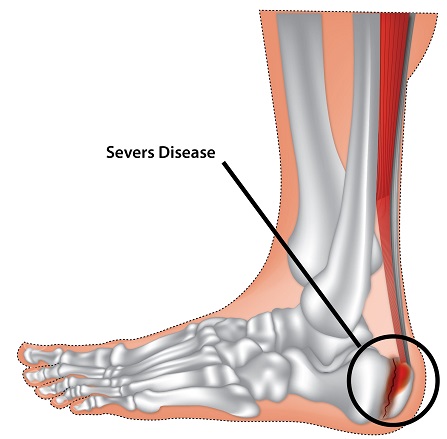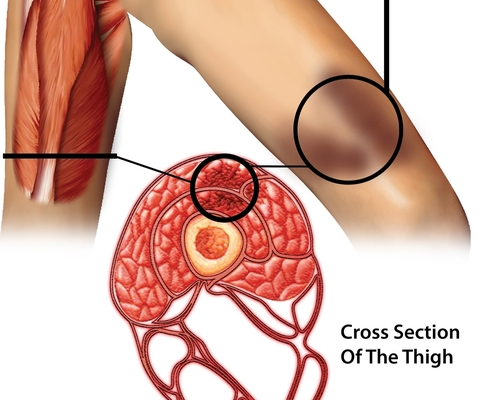What is Sever’s disease?

What are the symptoms of Sever’s disease?
This condition (also known as calcaneal apophysitis) predominantly affects active children who are experiencing sudden growth spurts, the main symptoms that accompany sever’s disease include:
- Pain in one or both heels, aggravated by increased activity.
- Limited ankle joint movement.
- Inflammation and redness around the heel
Sometimes the pain may become severe to the point to which the child will limp to avoid putting weight on the affected heel(s).
What are the causes and risk factors?
The most common cause for this injury is the overuse and stress on the heel bone through increased activity whilst a growth spurt occurs. The growth plate on the heel is sensitive to repeated impact from activities such as running or football, leading to the cartilage tissue becoming inflamed.
Other potential causes of Sever’s disease include:
- Obesity
- Tight achilles tendon
- Structural problems (such as having a flat foot or high-arched foot).
Those most at risk of having this injury are children going through puberty, who are experiencing growth spurts. It can occur anytime between 5-13 years old for girls and 7-15 years for boys. Other risk factors associated with Sever’s disease include:
- High levels of impact sports which require constant movement of the feet
- Tight plantar fascia muscle
- Deficiency of Vitamin D
How is Sever’s disease diagnosed?
To diagnose this injury (calcaneal apophysitis), the health specialist will usually examine the young person using a mediolateral compression of the heel in the area of the growth plate in the absence of more serious causes such as trauma.
X-rays are not used in diagnosis as they cannot show the problem, but are sometimes used to rule out other problems such as fractures.
How is it treated?
Children with this condition are recommended to cut down or stop all activities that contribute to pain in the area. Your GP or physiotherapist will usually provide you with the most appropriate course of treatment, but generally the treatments include:
- bracing of the heel
- heel lift exercises
- stretching of calf muscles
- splinting at night
- heel inserts for shock absorption
- medication for pain such as ibuprofen or acetaminophen
- ice (2 to 3 times a day)
- steroid injection
- casting or crutches.
FAQs
Q. Can children still play sports with Sever’s disease?
A. It is best that the injury is fully healed and that the child feels no pain when returning to sport.
Q. How long does Sever’s disease last?
A. It can last anywhere between 2-6 months in a young person. This is also highly dependent on the individual’s growth spurt, type of activity, and treatment plan.
Q. Is Sever’s disease the same as plantar fasciitis?
Although both injuries affect the foot, Sever’s disease is related to inflammation and soreness at the heel of the foot, whilst plantar fasciitis is an injury that affects the sole of the foot.
Q. Does taping help Sever’s disease?
A. Taping has been said to be effective in relieving pain for those suffering from Sever’s disease. It is said to effectively decrease strain on the Achilles tendon, reducing pain at acute stages.
SOURCES
[1] Haglund P. Ueber fractur des epiphysenkerns des calcaneus, nebst allgemeinen bemerkungen ueber einige aehnliche juvenile knochenkernverletzungen. Archiv fur klinische Chirurgie 1907; 82: 922.
[2] Sever JW. Apophysitis of the os calcis. New York Medicine Journal. 1912; 95: 1025.
[3] Harding VV. Time schedule for the appearance and fusion of a second accessory center of ossification of the calcaneus. Child Development. 1952; 23: 181.
[4] Hoerr NL, Pyle SI, Francis CC. Radiographic Atlas of Skeletal Development of the Foot and Ankle. Charles C. Thomas, Springfield, IL, 1962.
[5] Micheli LJ, Ireland ML. Prevention and management of calcaneal apophysitis in children: an overuse syndrome. Journal of Pediatric Orthopaedics. 1987; 7:34.
[6] Kvist MH, Heinonen OJ. Calcaneal apophysitis [Sever’s disease] a common cause of heel pain in young athletes. Scandinavian Journal of Medicine & Science Sports. 1991; 1: 235.





![Temporomandibular_Joint-min[1]](https://www.sportnova.co.uk/wp-content/uploads/2016/07/Temporomandibular_Joint-min1-479x400.jpg)